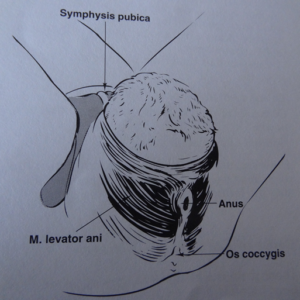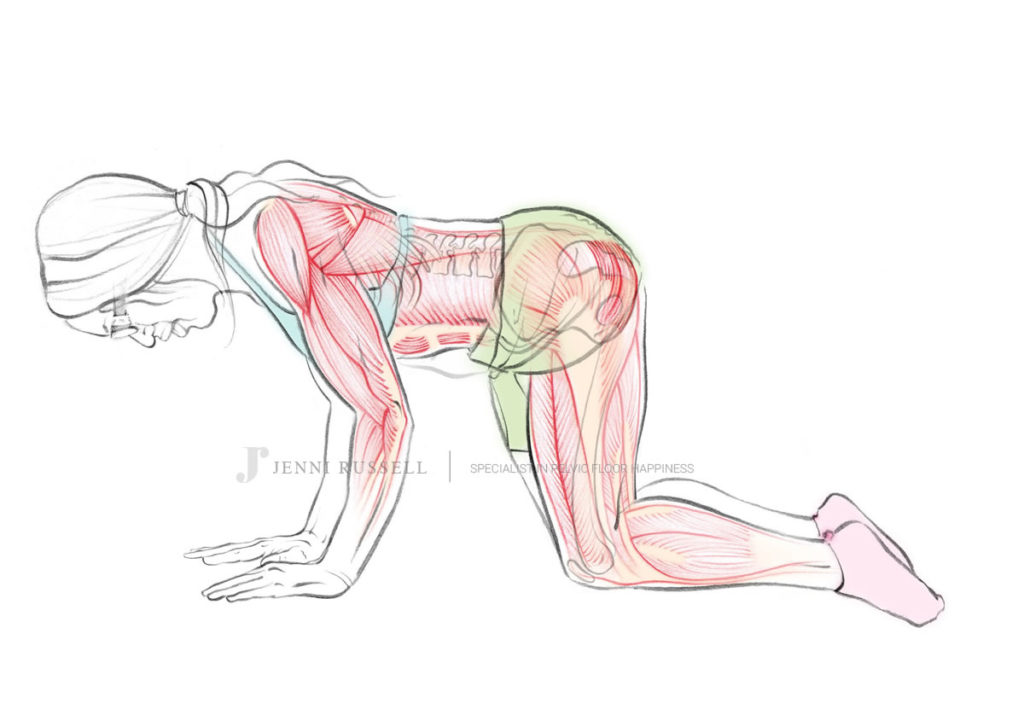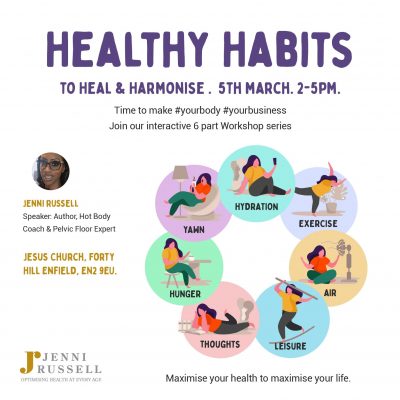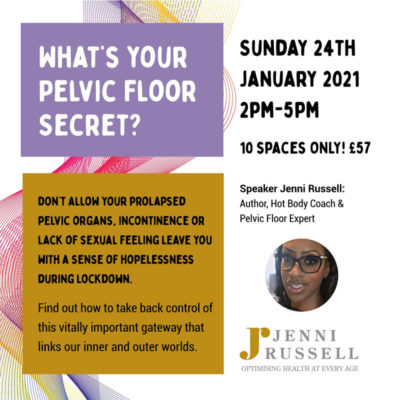BLOG
Jenni Russell’s latest news and information
Let’s talk about Sex – after baby!
One of the main reasons I ever got involved in pelvic floor health and happiness in the first place was to ensure that after childbirth I would never have an “Are we there yet moment” when I returned to having sex! That throwaway comment one of my best mates said to me way back then after his second child was born: “Now I know what it means when they say it’s like dipping your wick in a well,” drew my attention to my pelvic floor muscles. By default it saved me and has saved hundreds of women since from a lack of sexual feeling after vaginal delivery. It was the reason I wrote my first book ‘Can a Vagina really buy a Mercedes?” back in 2005. Everybody wants to have great sex and for me it does come in the top five of the best feelings in the whole world. ‘Feeling’ being the operative word! So this week I think its time we talk about sex – after baby.
It imperative for us to have a better understanding of these vitally important and beautiful muscles that link our inner and outer worlds. Muscles that are responsible to create this orgasmic expression, but also to ensure that sex is something that can be enjoyed right into older age.
This is why I have dedicated my skill and my energy to pelvic floor health and happiness. My pre and postnatal programmes offer the best solutions:
- The vital education that is necessary to create awareness.
- The ‘appropriate’ exercises through the trimesters and postpartum to address postural changes and ensure pelvic floor integrity in preparation for second stage delivery.
- The rewards that encourage and motivate the mother and ensure the best for the baby also.
It is my passion to ensure every woman can have ‘confidence, continence and sexual satisfaction’ before during and after childbirth.
The everyday of the pelvic floor muscle is support and stability of the pelvis, postural integrity, gait and movement ability as well as support of the internal organs and continence. When it comes to sex, they play a vital role in the ‘massaging, gripping and pulling in’ of the penis. The more responsive they are the better the sexual experience, coupled with the body’s ability to ‘isolate’ the pelvis further increasing a reflexive response from them. It is the friction that is created that allows for many to experience explosive orgasms and maintain stamina to continue. So it is understandable that many women afraid of losing this ability, may opt for a caesarean section in the hope they can avoid any issues, but that can bring its own complications.
If we make these muscles a part of our acquired knowledge before, during and after pregnancy and childbirth we can actually help to prevent or minimise any muscle weakness or dysfunction that inhibits great sex or sexual feeling. Not every woman has a vaginal orgasm, but many women state they are unable to ‘co-ordinate’ their body well enough with the partner or husband, to generate the feeling that is necessary to make this happen in the first place and this is where the issue begins. Fundamentally this is because far too many women are still unaware they have muscles down there or they don’t even know how to activate or use them in order to create the orgasms they crave, much less improve their everyday role and responsibilities.
The shocking thing is that over 200 million women around the world are still unaware of something as simple as the ‘kegel’ exercise (Iranian journal of nursing and midwifery research May 2015), much less where their pelvic floor is or what role it plays in their life, other than after babies. The knowledge seems to be elusive, as is the attention given during antenatal care and thus the problems linked to trauma in childbirth and postpartum, is such that many are now opting for C-section.
The first thing that needs to happen after childbirth (vaginal especially) is that sensory communication needs to be ‘re-set’ as soon as possible. As your baby exits through the vaginal canal, your pelvic floor muscles exit for a moment also and then return. This relaxation and stretch of the muscles means they definitely need some attention to return them back to their pre-baby condition. Muscles respond to stimulation and resistance and this happens best when blood flow is optimal and the right nutrients are available to ‘plump’ them back up. Two things are necessary:
- Optimised breathing – no doubt about it, our ability to breathe diaphragmatically is removed at the point of labour and childbirth. The pain that comes with contractions means our breathing becomes short and shallow. Couple this with any additional trauma and it reduces further. It is the pumping action of the respiratory diaphragm, which directly impacts the abdominal wall and pelvic floor. If the diaphragm is not working properly it is impossible to have full function of these two areas – and postpartum they are the two areas everyone takes their focus to. When the diaphragm is working properly, blood flow is optimised and vital nutrients can feed the muscles to help improve their restoration, repair and responsiveness, thereby restoring integrity.
- Optimised Nutrition – is vital for the repair and restoration of the muscles that have just been through pregnancy and birthing trauma. Improving central nervous system function is vital for communicating to the pelvic floor muscles to offer support for voiding, stability and ultimately sexual response. Vitamin B12 is a key vitamin for this, where Potassium improves nerve impulses (the way all muscle ‘speak’) and calcium is vital for muscle contraction and bone density for example. Food and food quality is vital. Wild fish as far as possible, outdoor reared organic meats and organic green vegetables all help to achieve this. Salt is vital also to improve muscle tone and strength and this is very important also for bladder weakness postpartum and can help to minimise the instance of incontinence.
Addressing both breathing and nutrient intake will help improve the sensory connection, which is the first step in being able to restore pelvic floor muscle function during intimacy. Once you have ‘re-awakened’ the pathways you can begin to look at other exercises necessary to support the pelvic floor muscles, which include looking at the function of the lower abdominal and multifidus.

Diaphragmatic breathing stimulates abdominal wall muscle function. A very simple exercise can be performed on all fours maintaining good alignment (hands directly under shoulders and knees directly under hips) with the head and neck and focussing on tummy vacuuming.
- Inhale and allows the tummy to ‘drop’ as it expands
- Exhale and imagine someone is ‘guiding’ your belly button slight upward to ward the sternum as well as back toward the spine.
This drawing up and in of the lower abdomen, will create a co-contraction of drawing up of the pelvic floor muscles. This one exercise combines the respiratory and pelvic diaphragms with the transverse abdominal muscles. But ensure the trunk (posture) has a good neutral line, no excess dip in the low back or dropping of the head, whilst engaging the triceps.
Pelvic rocks are also great to do and good for dis-associating the upper and lower body – great to improve before you return to intimacy, and helps stimulate pelvic floor muscle reaction. None of these require hours in the gym or home, but those simple moves alone just help to re-awaken the muscles, re-align and re-vive them.
In France it is mandatory to have pelvic floor physical therapy after childbirth but not here in the UK. My postpartum programme incorporates nutrition and lifestyle, postural, emotional and physical considerations that really do offer the best solutions for your overall wellbeing and sexual satisfaction.
Sex after childbirth can be even better than before – it just requires the right of knowledge and application. There is no better technology than your body. Learn how this beautiful bit of technology works and become the body genius that you are and enjoy all the sex your body can handle.






